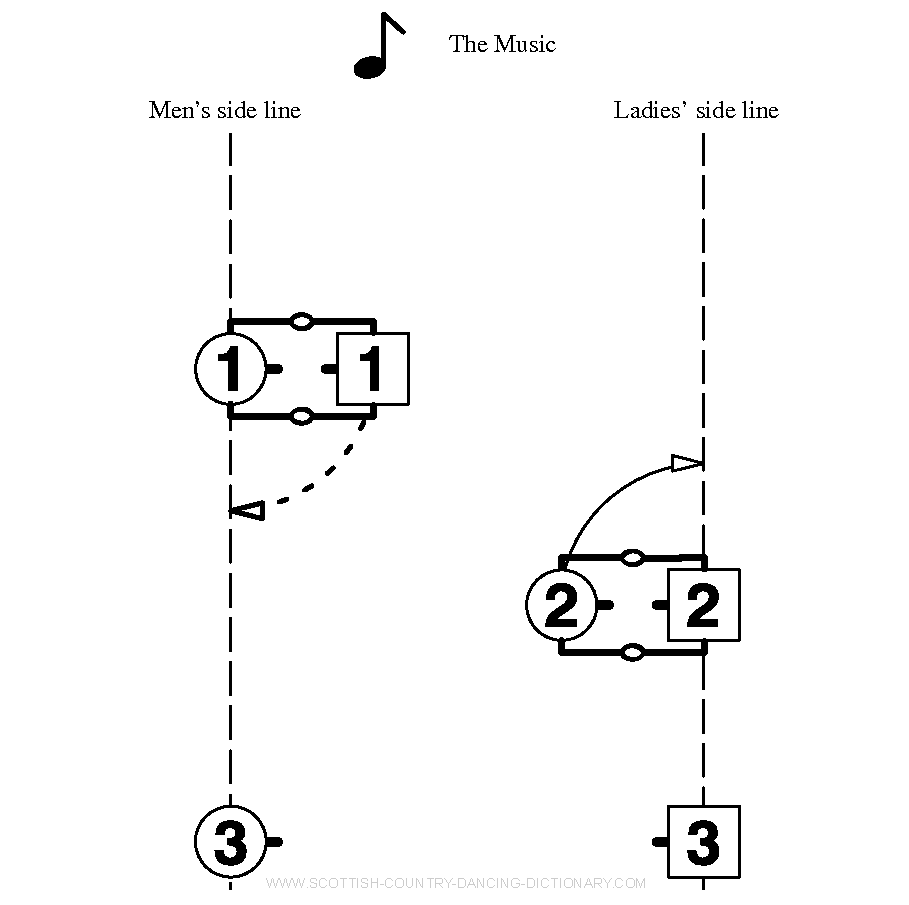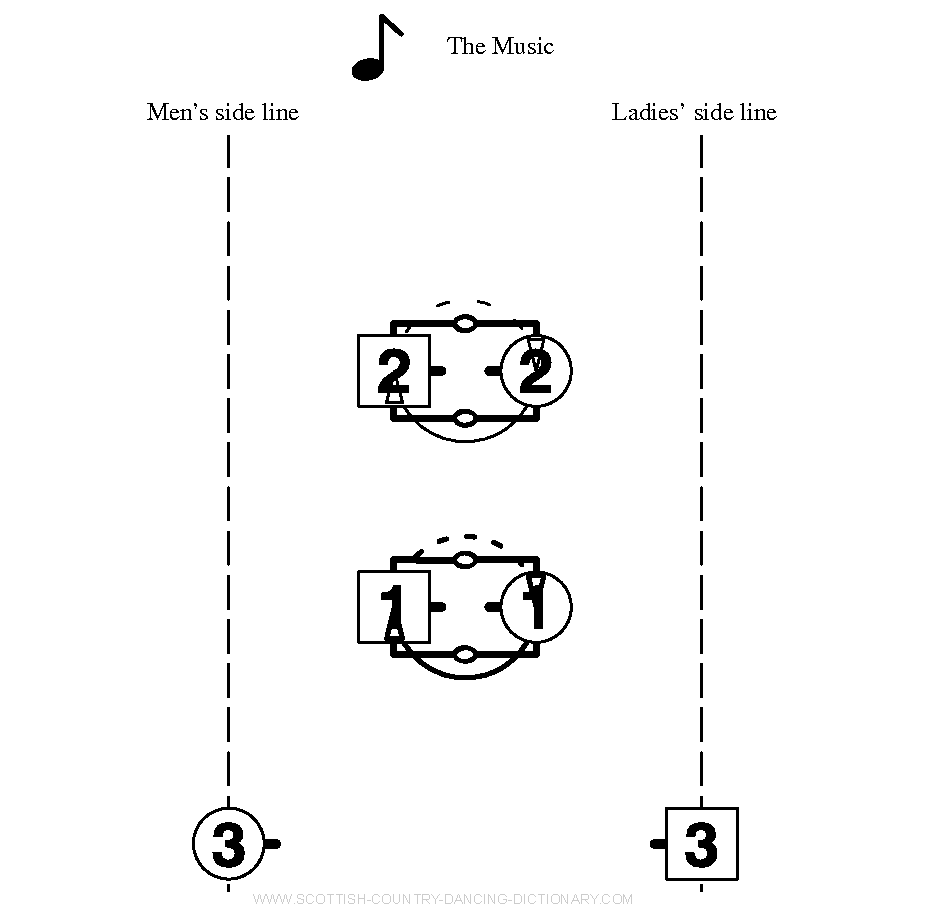Poussette
The Poussette in Scottish Country Dancing is a traditional, formally prescribed, Figure which, like Allemande, is used as an elegant means of Progression, i.e., interchanging the Places of two adjacent Couples.When not otherwise qualified (see Strathspey poussette), this Figure can only appear in Quick tempo dances; the whole Figure requires 8 bars, i.e., four complete Pas-de-basque steps.
Much as with Allemande, derivative forms do exist for more than two Couples, or with the elegant movements squeezed into fewer bars, though, blessedly, dances including these rarely appear.
When danced by the 1st and 2nd Couples Starting from their Original Positions but on the Centre line, the movements for bar 1 are shown in the first diagram, for bar 2 in the next diagram and so on; bars 7-8 are shown in the same diagram and the Finishing Places at the end of bar 8 in the following diagram.
At the beginning of the 8-bar phrase, the two Couples Start on the Centre line, Facing Partners Across The set, and Take Both hands, retaining this Hold for the first 6 bars. As with Allemande, there is no Time at the beginning of the Figure to reach the Centre line from the Side lines:
- if stationary and the first Pas-de-basque step of the Poussette is to be performed with the right foot, each Dancer must Advance toward the Centre line on the last bar of the preceding Figure, using the left foot step of Skip change as in Skip Change - Bar 2 (but note that the left foot would be in first Position at the beginning of the first beat from Standing);
- if stationary and the first Pas-de-basque step of the Poussette is to be performed with the left foot, each Dancer must Advance toward the Centre line on the last bar of the preceding Figure, using the right foot step of Skip change as in Skip Change - Bar 1;
- if performing the immediately preceding Figure, the ending must be adapted so as to Finish on the Centre line.
Assuming that 1st and 2nd Couples are performing the Figure after having moved to the Centre line from their Original Places:
Bar 1
Taking Both hands, 1st Couple Dance towards the Men's Side While 2nd Couple Dance towards the Ladies' Side, i.e., 1st Man and 2nd Lady Dance backwards to Finish in their Own side lines While their Partners Dance forwards;

Poussette in 3-couple Longwise Set, Bar 1
2nd lady's path shown as a broken line;
arrow heads show Finishing Positions for 1st man and 2nd lady but not their Facing Directions.
Bar 2
both Couples rotate one quarter, clockwise, 1st Man and 2nd Lady Dancing On the spot While their Partners step to their left, 1st Couple Finishing in the Men's Side line, 2nd Couple in the Ladies' Side line;

Poussette in 3-couple Longwise Set, Bar 2
2nd man's path shown as a full line;
arrow heads show Finishing Positions for 1st lady and 2nd man but not their Facing Directions.
Bar 3
1st Couple Dance Down the Men's Side While 2nd Couple Dance Up the Ladies' Side, Finishing with 1st Lady in 2nd Man's Place and 2nd Man in 1st Lady's;

Poussette in 3-couple Longwise Set, Bar 3
2nd man's path shown as a full line;
arrow heads show Finishing Positions for 1st lady and 2nd man but not their Facing Directions.
Bar 4
both Couples rotate one quarter, clockwise, 2nd Man and 1st Lady Dancing On the spot While their Partners step to their left, Finishing Facing Own Sides;

Poussette in 3-couple Longwise Set, Bar 4
2nd lady's path shown as a broken line;
arrow heads show Finishing Positions for 1st man and 2nd lady but not their Facing Directions.
Bar 5
both Couples Dance to the Centre line, i.e., 1st Man and 2nd Lady Dance backwards While their Partners Dance forwards;

Poussette in 3-couple Longwise Set, Bar 5
2nd lady's path shown as a broken line;
arrow heads show Finishing Positions for 1st man and 2nd lady but not their Facing Directions.
Bar 6
both Couples Turn halfway, clockwise, to their Own sides;

Poussette in 3-couple Longwise Set, Bar 6
arrow heads show Finishing Positions but not the Facing Directions.
Bar 7
all release hands and begin to Retire toward their Side lines;

Poussette in 3-couple Longwise Set, Bars 7-8
arrow heads show Finishing Positions but not the Facing Directions.
Bar 8
all Retire to their Side lines, 1st Couple now in 2nd Place, 2nd Couple in 1st Place.

Poussette in 3-couple Longwise Set, at end of Bar 8
According to conventional RSCDS teaching, the Men should Start the first bar of the Poussette by using the left foot step of Pas-de-basque, i.e., as in Pas-de-basque - Bar 2 whereas their Partners should Start normally, using the right foot, i.e., as in Pas-de-basque - Bar 1. When Poussette is performed in this way, 2nd Man (on bar 2), 1st Man (on bar 4) and both (on bar 6) must Travel to the left on a right foot step and, in bars 1-6, all must be careful not to kick Partner in the jeté. These feats are possible for a highly expert dancer but counter-intuitive and unnecessarily difficult for the less experienced. Furthermore, the transition from the left foot Finishing step of any preceding Figure and to the right foot Starting step of any succeeding Figure can be very complicated.
This convention is difficult to justify, unless it was intended to accommodate the Pas-de-basque step being performed with an incorrectly large movement to the side on the first beat. It may have arisen by false analogy with the differentiation which is essential in the Strathspey poussette though, in that case, it is 1st Man and 2nd Lady who Start on the left foot and their Partners normally. In any event, precision in the formally rectilinear movement is much more important (and much easier to achieve if the Men Start on the right foot); so long as that is correct, only the most pedantic, and observant, Lady Partner would be concerned about which foot her Man Starts on.
See Starting Poussette On Left Foot for more extensive consideration of the topic.
Here are examples of those Scottish Country Dances for which we have instructions on this site and in which the term, Poussette, either appears explicitly or is implied; note that for a common term these will be a small selection; for a rare term, these may be all that exist:
Dancing In The Street
Dark Island
Flowers Of Edinburgh
Ladies' Fancy
Milton's Welcome
Muirland Willie
Rothesay Country Dance
Ruby Wilkinson's Farewell To Cranshaws
Scottish Reform
Summer Wooing
Dance Video Clip Which Demonstrates Poussette
Poussette Video ClipLinks To Pages Related To 'Poussette Movements'
Complex FiguresAdditional search terms: Pouset, Pousette, Poussete.
Back to the top of this Scottish Country Dancing 'Poussette' page